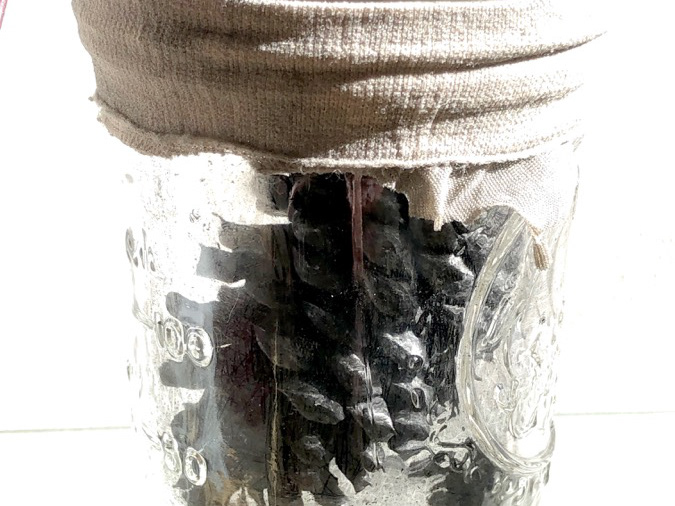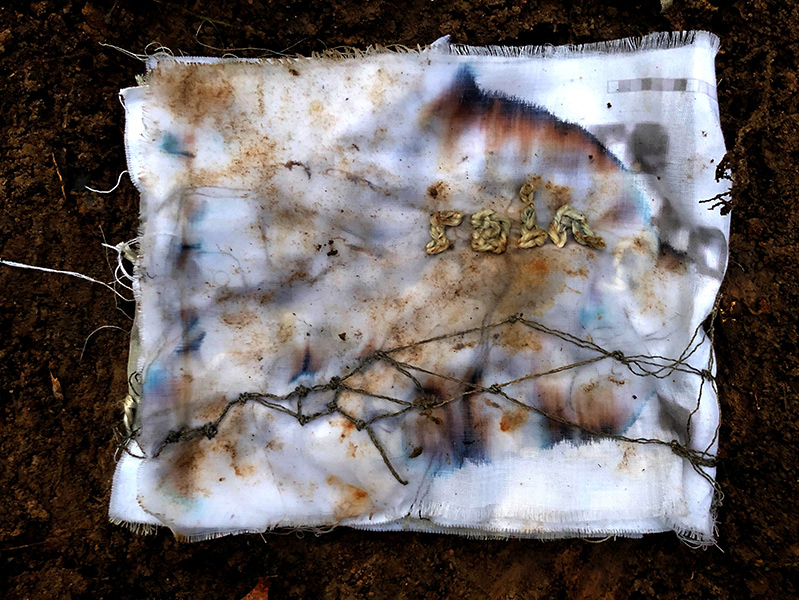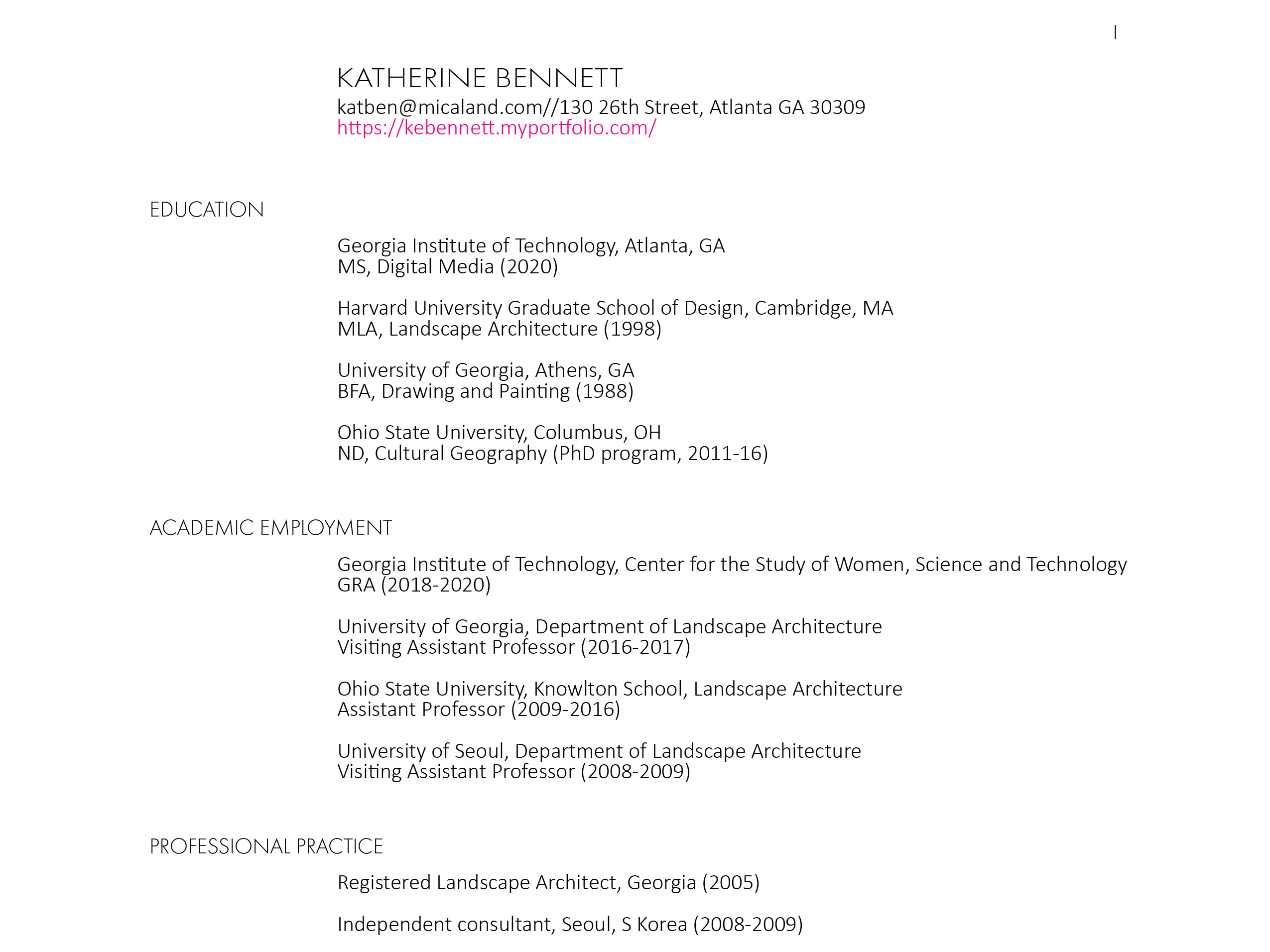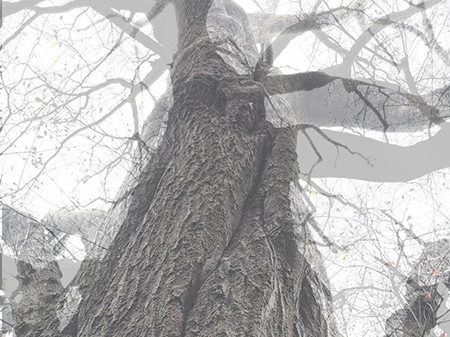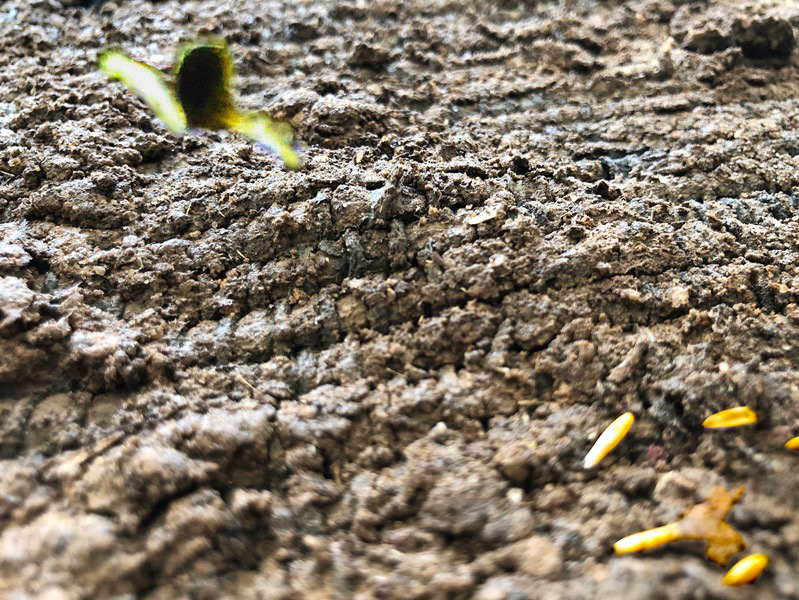Collage, Katherine Bennett, 2018. Final project image.
Dear Crosswalk,
TEAM Jordan Chen and Samantha Hudock
FALL 2018, Professor Nassim Parvin, GTA Aditya Anupam
Project description. This 5-week collaborative project developed through two phases of investigation into research methods associated with (1) scientific and (2) ethnographic modes of inquiry. Our project centered on a crosswalk at the corner of Spring Street NW and 5th Street NE in Atlanta. This intersection serves as an eastern hub for a recent extension of the Georgia Tech campus into Midtown Atlanta — So the crosswalk itself marks a crossing of the Interstate 75-85 corridor, which for many years has been the campus's eastern boundary. The design of this crosswalk allows multi-directional pedestrian crossing of the Spring and 5th intersection during a timed, full-stop interval for all vehicular traffic on the two streets. This exclusive, diagonal-or-straight-across crossing delights many pedestrians who use it regularly, and has alleviated rush-hour traffic congestion at a crunch-point of the two 4-lane arterial streets.
Multi-directional crosswalk at the intersection of Spring St NW and 5th St NE in Atlanta. Aerial photo source: Google Earth.
Group observations, phase 1. Our series of maps, photos, drawings, and notes (below) records our observations of pedestrian and vehicle/driver behaviors at the Spring and 5th crosswalk during the 10 days of our "scientific" phase of study. In this phase, we adopted our interpretations of three observation-based methods described in the book, Universal Methods of Design: 100 Ways to Research Complex Problems, Develop Innovative Ideas, and Design Effective Solutions, by Bruce Hanington and Bella Martin, 2012: (1) AEIOU, (2) Behavioral Mapping, and (3) Personas:
Chart of methods and limits, Katherine Bennett. Methods adapted from Hanington and Martin (2012).
Mappings, phase 1. Our project maps follow the Behavioral Mapping method described by Hanington and Martin (2012). The map diagram and photo-montage drawings (below) track a sequence of pedestrians, and one person on a scooter, during a 20 second interval at the Spring and 5th crosswalk. The sequence-interval begins one second (-1) before a red light for vehicles and a walk signal for pedestrians and scooters. At the beginning, one pedestrian is waiting to cross diagonally from the SE corner to the NW corner of the intersection (photo perspective far left). Numbers indicate timing: from -1 second (a second before the light change), to 0 (at the light change), to 1-18 (the seconds following until just after the next light change).



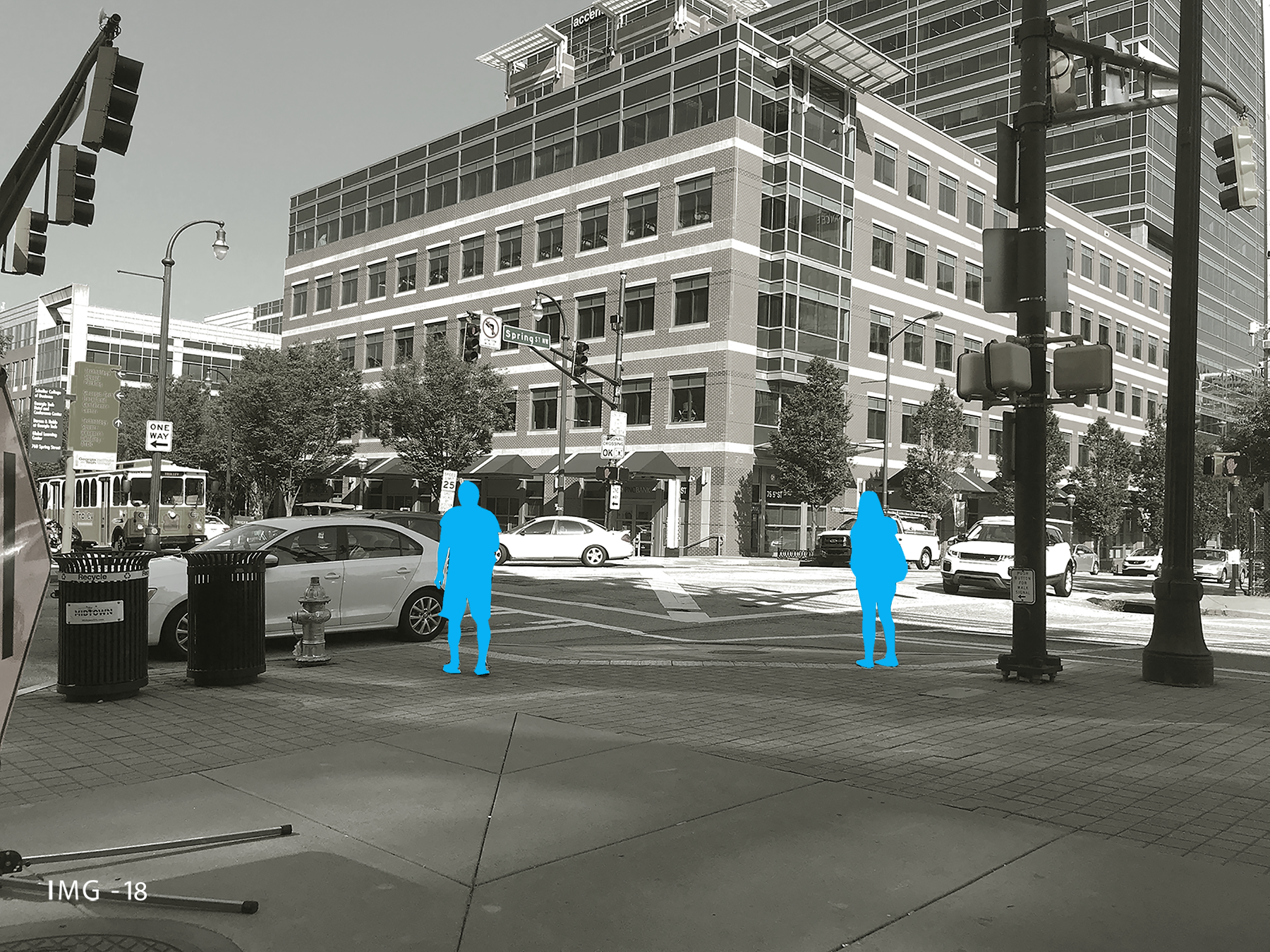
Final map diagram and photo-montage drawings, Katherine Bennett, 2018. Aerial photo source: Bing.
Drawings, phase 1 (cont'd). Jordan composed and completed the forms below out during team field observation sessions. His text notes and sketches follow the AEIOU method described by Hanington and Martin (2012) in focusing on each of the observation categories, Activities (not shown), Environment, Interactions, Objects, Users. Jordan's description is here (https://jordanchen.net/crosswalk-research). See also Samantha (Sammi) Hudock's discussion here (https://www.sammihudock.com/researching-transition-spaces).


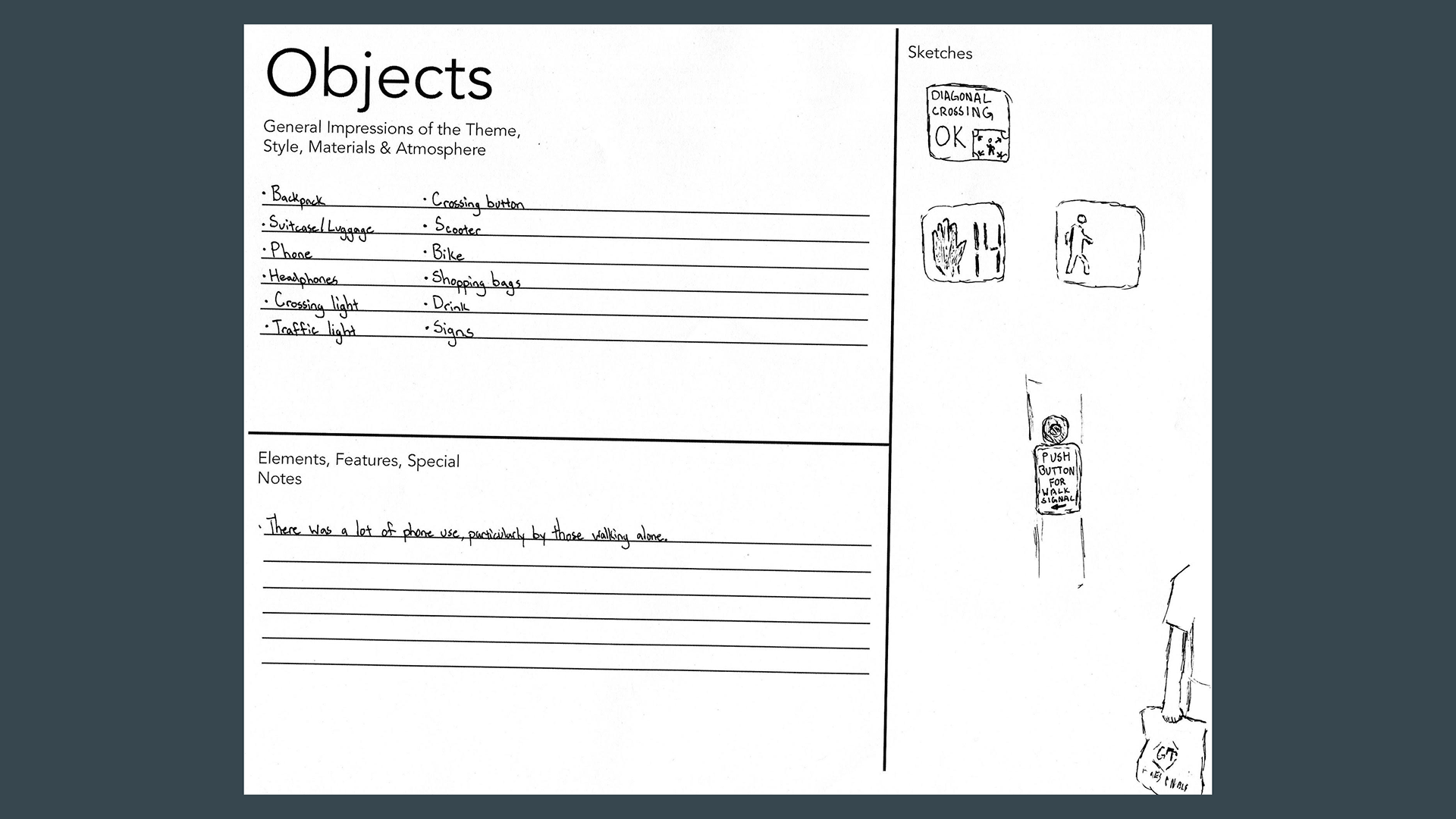

Observation forms, notes, and sketches, Jordan Chen, 2018.
Ideation, sketches and team notes, phase 1. We arrived at the Spring and 5th crosswalk as a study subject through a group brainstorming session and subsequent discussions. Our brainstorming list of potential study topics, and other crosswalks that could be studied, is here. We decided on the Spring and 5th crosswalk due to its innovative novelty in Atlanta and its effectiveness in mediating pedestrian and vehicular circulation. Sammi knew of this crosswalk's beneficial impact on traffic flows through her work with the campus planning office. We chose scientific, observation-based methods of study by reading and discussing various methods outlined by Hanington and Martin (2012), as summarized and represented above. We favored several ethnographic methods, recognizing that observation alone could not account for the behaviors we'd begun to observe. But we had to defer these qualitative methods to phase 2 of the project.



Field observation notes (left) and sketches (center), Katherine Bennett. White board meeting notes (right), Katherine Bennett, Jordan Chen, Samantha Hudock.
Refinement and development, drawings and critique, phase 1. The map diagrams below use isosceles triangles to represent pedestrians (smaller yellow triangles), a scooter/person (smaller orange triangles), and automobiles (larger orange triangles). Although the triangle geometry of the symbols for people, scooter (drivers), and vehicle (drivers) indicates movement, I have never liked the abstraction of people as triangles in these maps (that I made). The reduction of soft, idiosyncratic bodies to hard, standardized geometries feels almost brutal. It fails to convey the vulnerability of bodies — especially those unprotected by the steel shells of cars, trucks, and buses. I agree with our GTA, though, that this reduction points to the categorical universalisms of the methods we employed in the project's first phase.
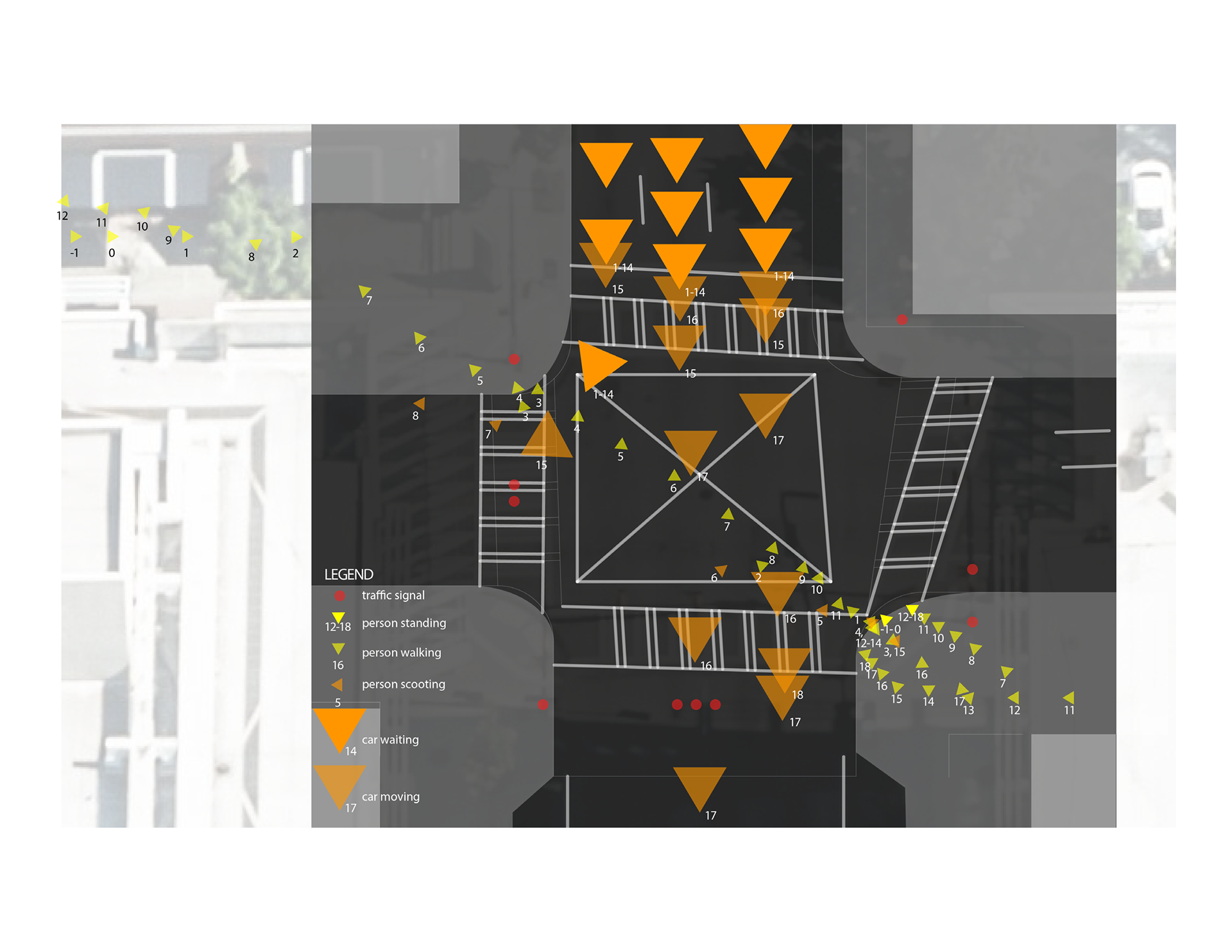



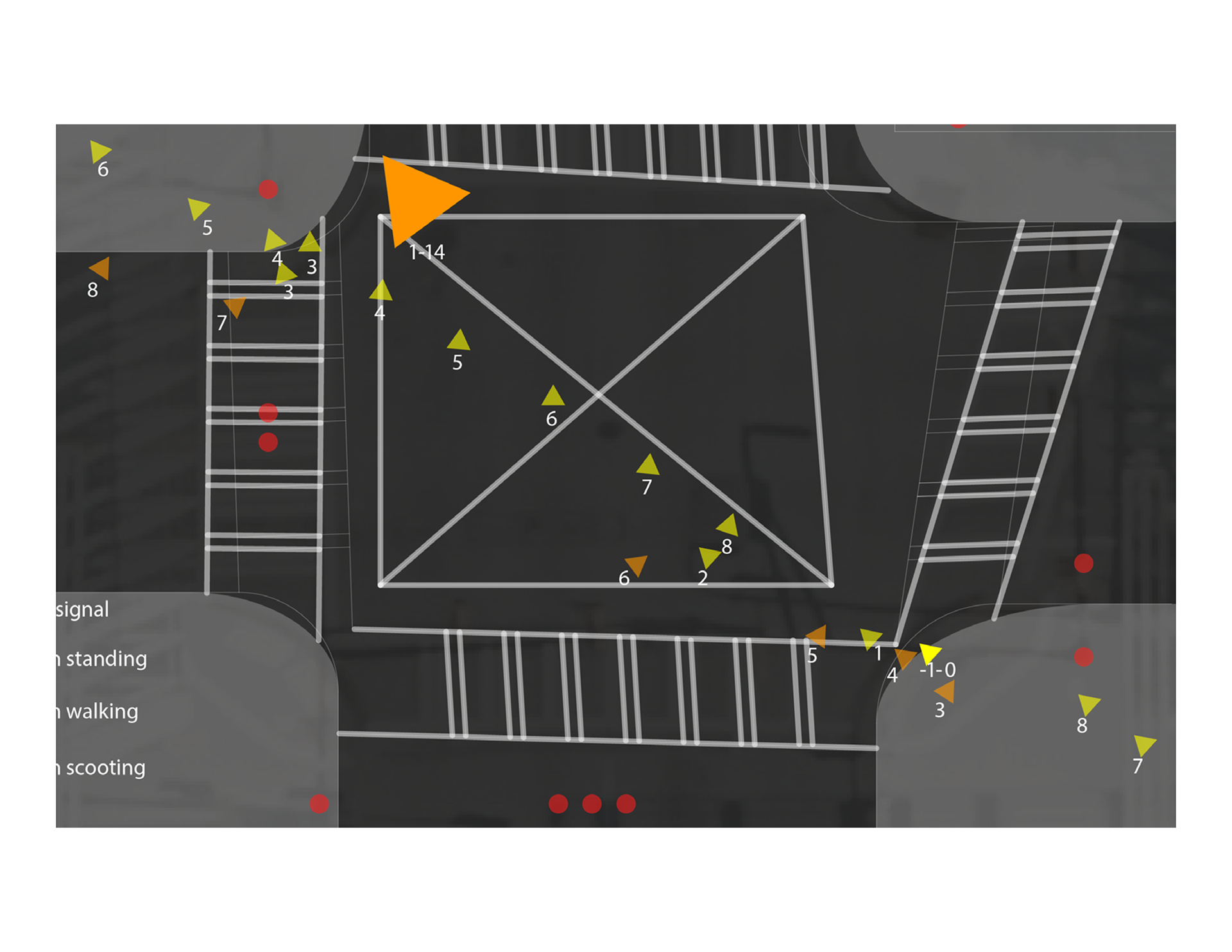
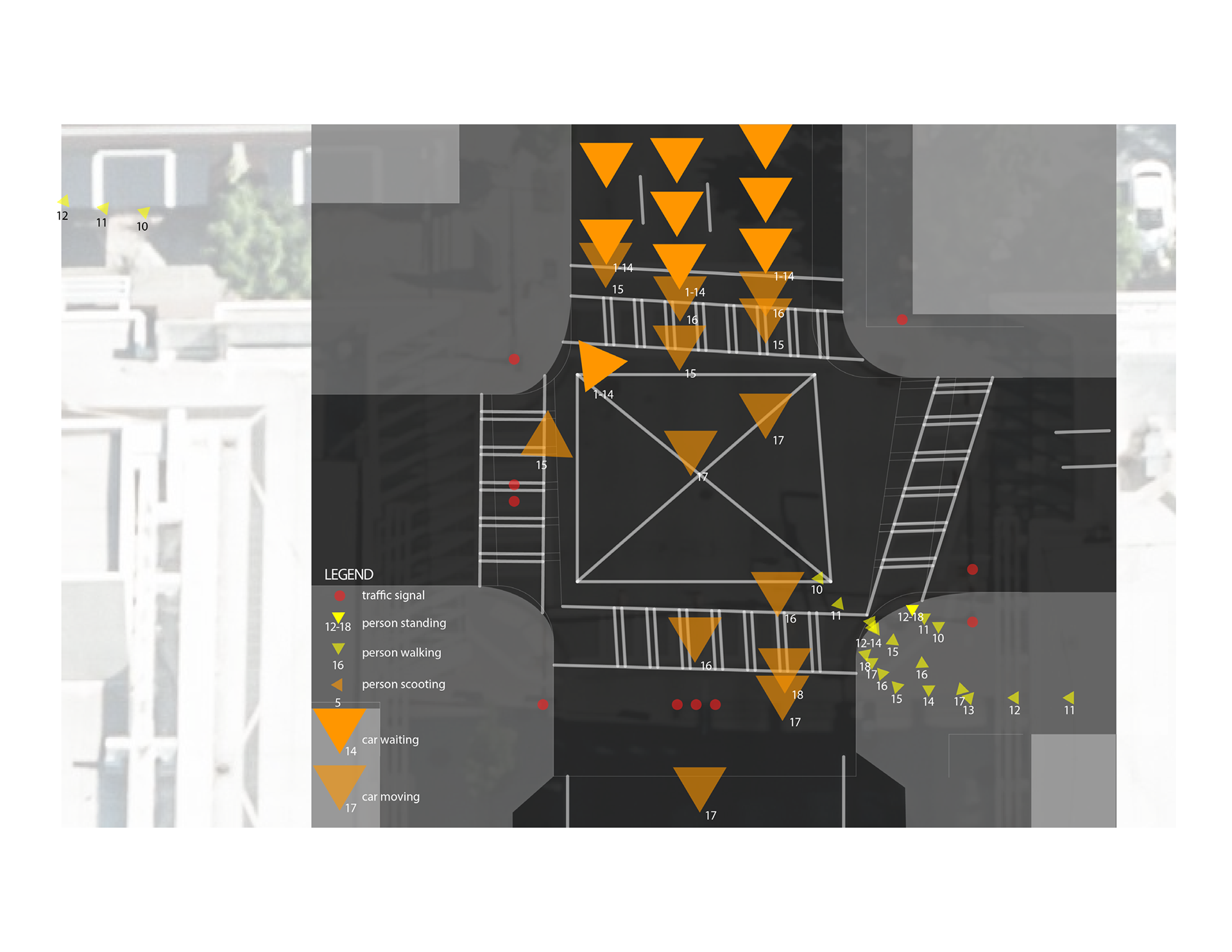

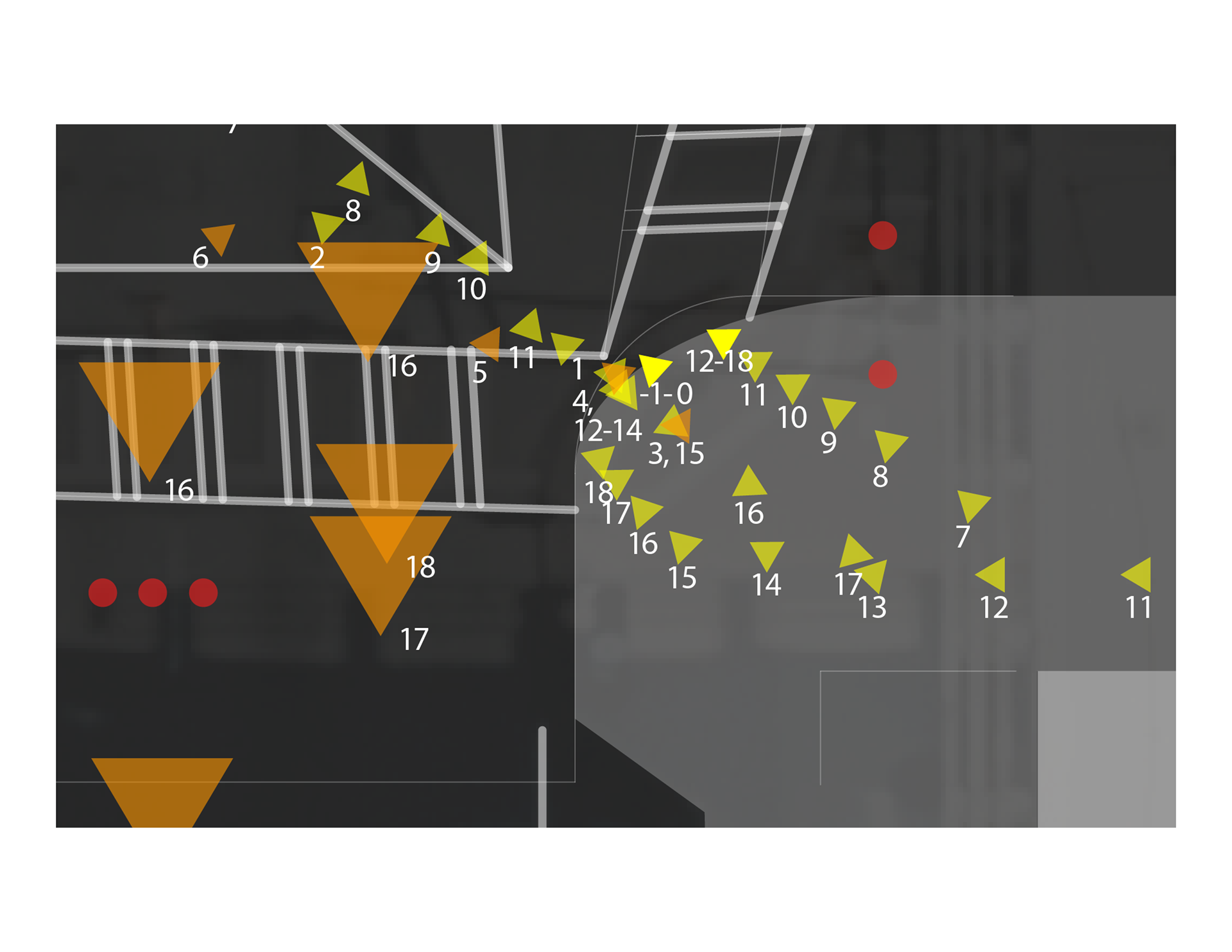


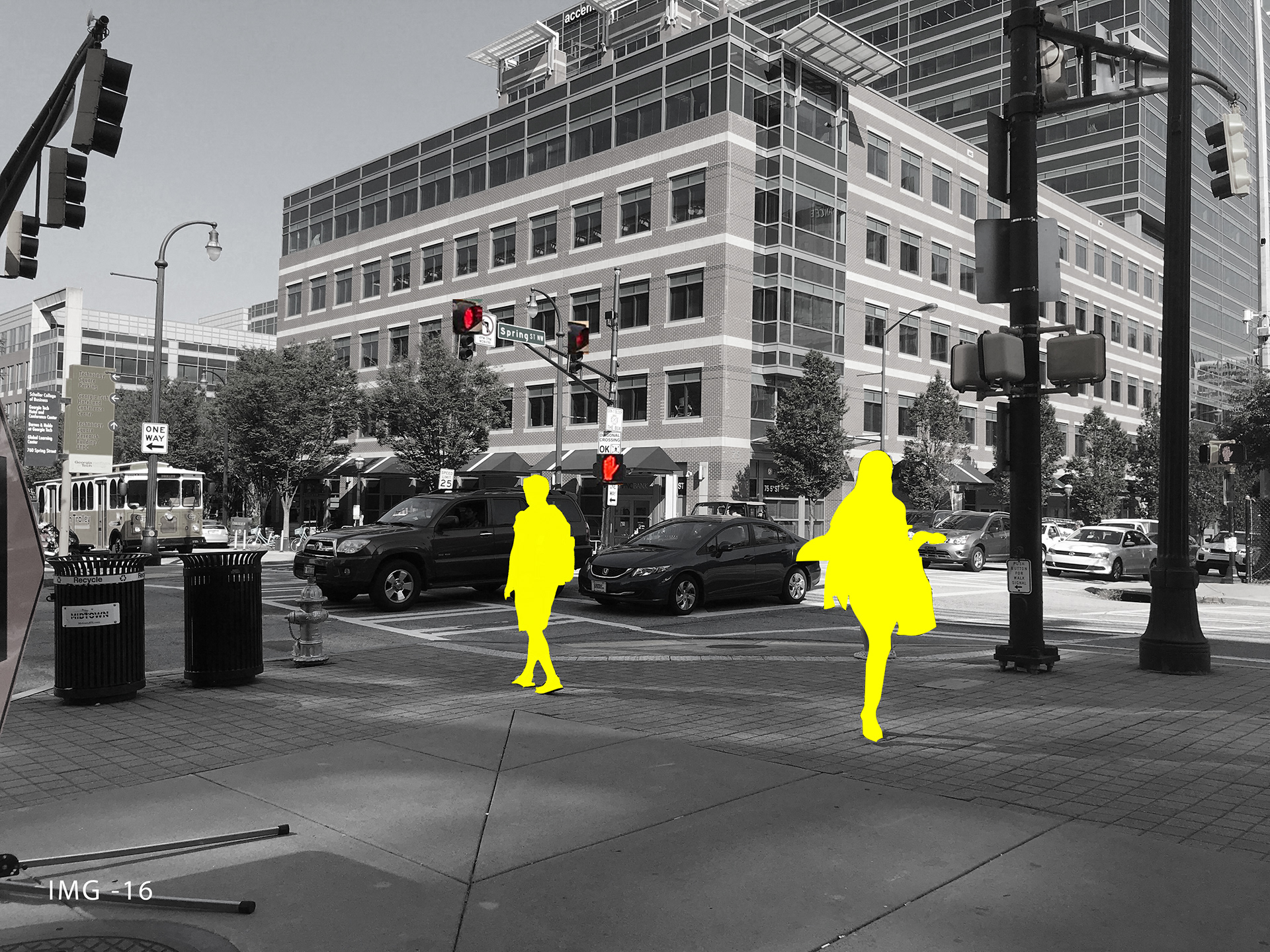
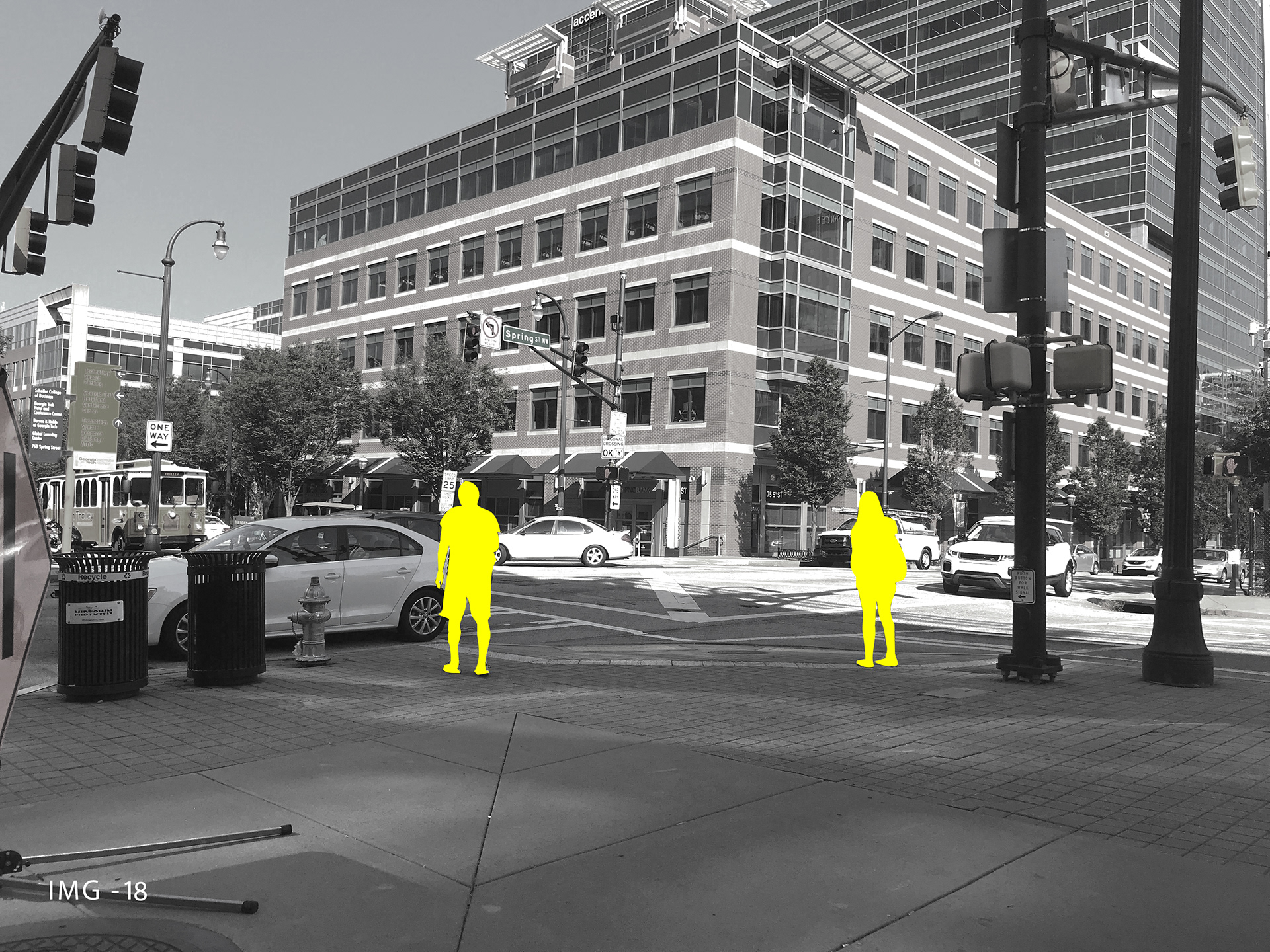
Draft map and perspective diagrams, Katherine Bennett. Aerial photo source: Bing.
Refinement and development, cont'd.
Critique of our final presentation noted that our findings were both too definitive, based on insufficient evidence, and yet, also, themselves insufficiently defined. The project's 10-day schedule and limited number of field observations did not allow for the degree of resolution that we were tempted to make (e.g. "Pedestrians slow down as they approach the sidewalk after crossing the intersection."). At the same time, we did not sufficiently focus our scope of inquiry -- the research question we wanted to examine. We refined our inquiry in the project's second phase (below).
Following Dr. Parvin's suggestion during the presentation, I have changed the shape of the triangles. In the final iterations at top and below, wider triangle bases clarify the direction of moving subjects. While projecting the diagrams, I also wasn't happy with my initial color scheme. I had started with a dark street color to represent asphalt and a figure-ground condition of the street as a public space. (Figure-ground diagrams in architecture and landscape architecture tend to use dark colors to emphasize interior and exterior public spaces as figures against a lighter-colored "ground" of private spaces.) But as I thought more about the crosswalk during the project's second phase, I changed to a lighter background color for the street, leading to additional color and form changes in the triangle symbols:
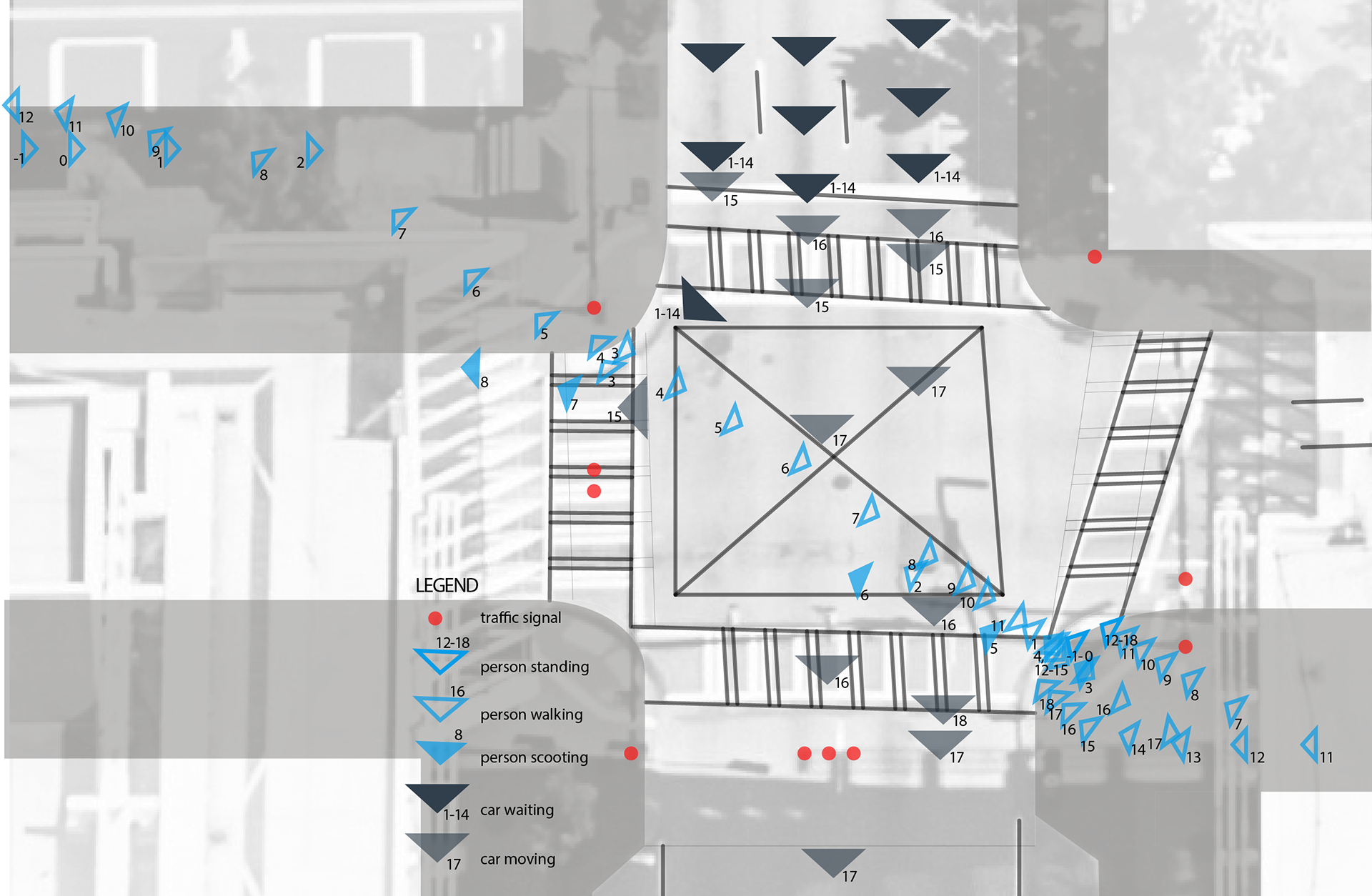
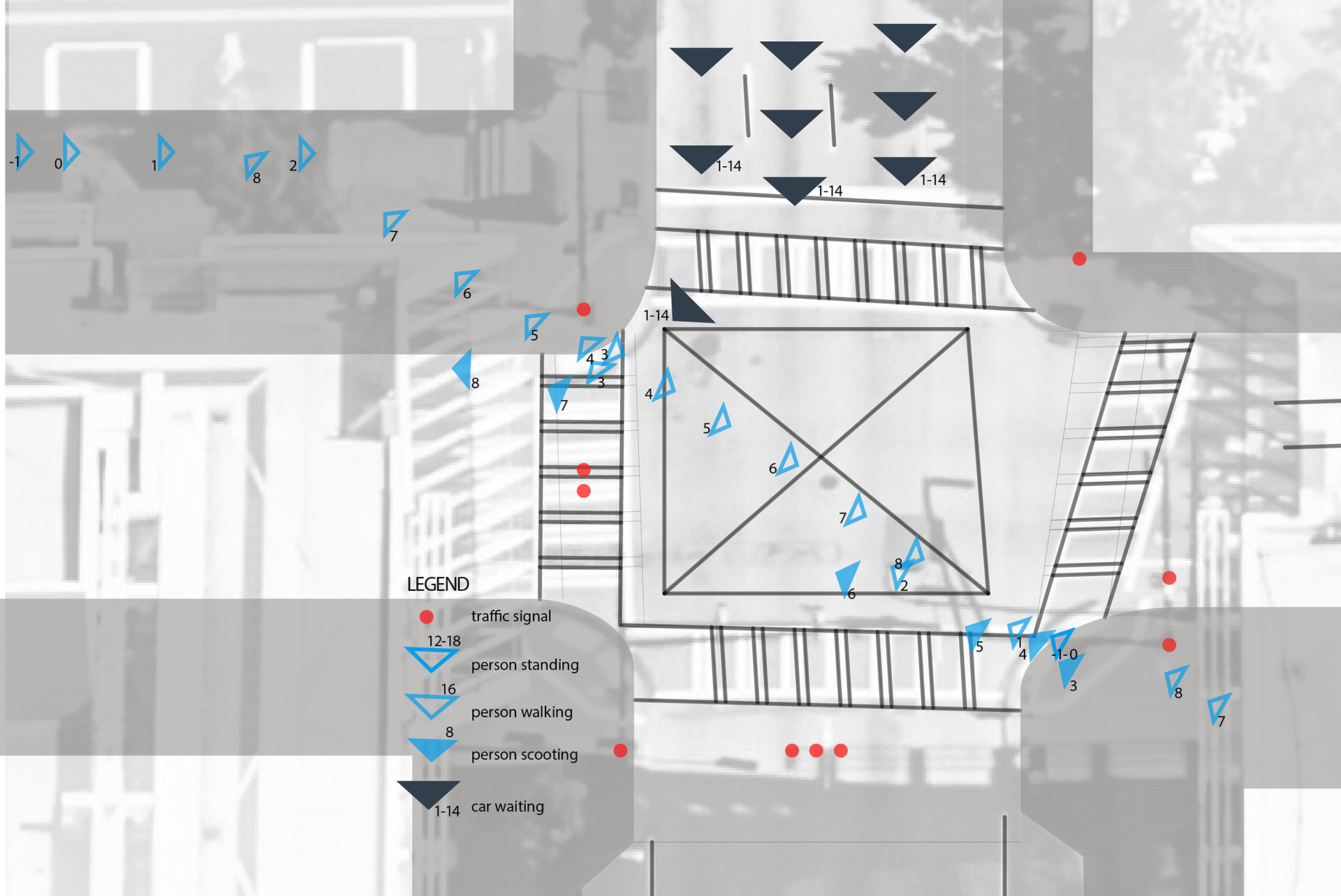

Map diagrams revised, Katherine Bennett. Background map image source: Bing.
Refinement and development, final drawings, phase 1. In phase 2 (description follows next image, below), we collected stories about the crosswalk from people who use it regularly, or (in one case) had just used it for the first time. These stories, along with my personal observations though both phases, led me to think of the crosswalk as an always-changing, continually rewritten text. The light gray of the street space in the screened aerial image is like the unprinted space of a book page, the space between the words and the characters composing the words. The darker gray of the pedestrian crossing graphics — the boxed "X" in the center indicating diagonal crossing and the (relatively) orthogonal lines indicating straight(ish)-across crossings — are the characters and words of this text. They communicate where and how pedestrians (and people driving scooters) are to negotiate the intersection during time intervals authorized by traffic lights and crossing signals. The moving bodies of pedestrians and scooters read and continually over-write the text of the crosswalk. In their rewriting, these bodies do not always obey the crosswalk's impervious characters, words, and signals.
This space of intersection, though nominally and financially public, effectively belongs to those who take it over, alternately vehicles and pedestrians/scooters. Conflicting desires of vehicle (drivers) and pedestrians/scooters jar for primacy and territory here. Traffic lights and crossing signals notwithstanding, drivers generally rule in the end: Pedestrians jaywalk between red lights and crossing signals, but only when (compassionate) drivers allow or when all drivers have passed through. The time-space of this crosswalk is a tense, mercurial negotiation between the conflicting desires of drivers, walkers, and scooters. Which — in my limited observation — drivers win.
Concrete poem. Don't Get Caught, Katherine Bennett, 2018.
Group interpretations, phase 2. Our series of collages, poem-drawings, and animations interpret different experiences of the Spring and 5th crosswalk. In this second, 10-day phase of the project, we combined and adapted three ethnographic research methods from Hanington and Martin (2012). These were (1) Directed storytelling (2) Love letter and breakup letter, and (3) Participant Observation:
Chart of methods and limits, Katherine Bennett. Methods adapted from Hanington and Martin (2012).
Stories and their representations, phase 2. Our selection of the Directed storytelling and Love letter and break up letter methods led us to collect stories from people who use the crosswalk. The results are compelling. They exceed our observations even more than we expected, giving us rich descriptions of different experiences, different perspectives, and different lives.
Gathering semi-directed stories through in-person exchanges, we were all interested in the emotions people felt during their experience(s) of the crosswalk and after, in their retelling and re-counting of those experiences. But the three of us did take slightly different tacks: Jordan was interested in how users craft a narrative around their experience (https://jordanchen.net/crosswalk-research). Sammi elicited nuances in how people use the crosswalk (https://www.sammihudock. com/researching-transition-spaces). I delved into larger stories and particular details of people’s lives, which emerged through their narratives.
The letters, too, are treasures. They crystallize the social with the physical dynamics of the crosswalk, expressing far more than any singular experience of it. The letters invoke the disorderly fullness of lives in their emotion-focused evocations of the crosswalk. The letters are poems.
My fascination with the visceral exchanges of the stories and letters led me to suggest a collage approach to our graphic and verbal re-presentations of our phase 2 findings. The relational interactions of the narrated stories and poem-letters evinced layers and textures, images and words. My collage of statements from our digital story and letter transcripts interweave with the texts of a handwritten love letter and handwritten break up letter (see images at top of this webpage and below.) The collage juxtaposes my photos of the two letters — the cropped upper half of a declaration of love, the cropped lower half of a decision to part. Sammi's story, also compiled of extracted quotes from these sources, also juxtaposes divergent voices — We read them aloud in our presentation. The interwoven texts together tell different but related stories. These stories are shared even as they conflict:

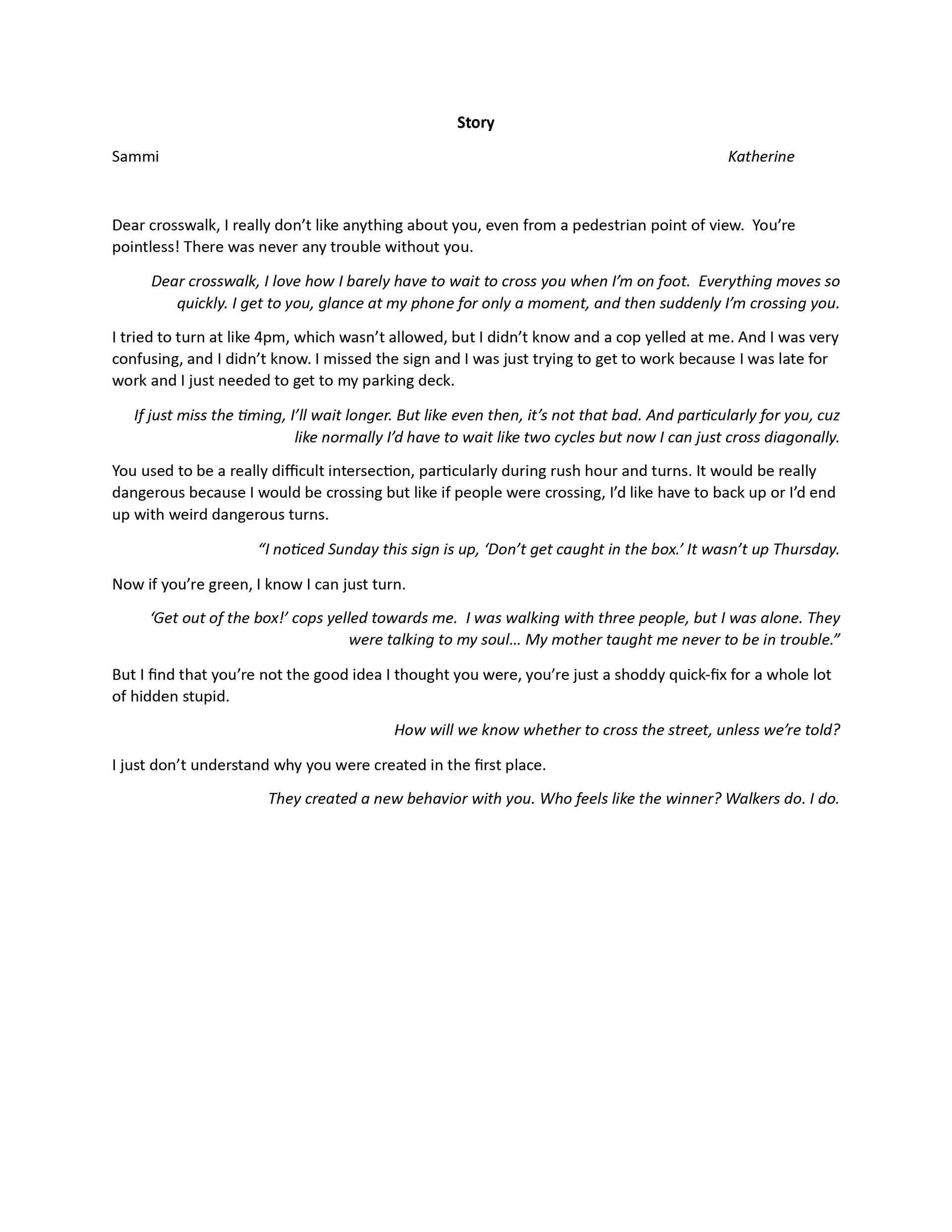
Collages: (left) visual, Katherine Bennett. (right) verbal, Samantha Hudock, 2018.
Poems and their representations, phase 2. Jordan and I composed poems to represent the stories we'd acquired through, in his case, reflexive participant observation and, in my case, directed storytelling and love/breakup letters. Jordan meticulously recorded the dates, times, and situations of his participant observations. His careful field notes produced a poem that captures fleeting negotiations of the crosswalk's transitional space.
My poem, inspired by concrete poetry and an animated story shown in class, emphasizes the spatial figure of the crosswalk's X intersection. The stories and letters we collected dwelt mostly on the Spring and 5th intersections' diagonal crossing "box," generally ignoring its conventional, transverse crosswalks. Several stories and letters refer to the admonitions of signs and police: "Don't get caught in the box" after light changes. Street signs (at Georgia Tech and in Philadelphia, the home of one storyteller) address drivers. Police, stationed at the Spring and 5th intersection shortly after the box's introduction, yelled alternately at drivers and pedestrians.


Poems. (left) Move poem, Jordan Chen. (right) Don't Get Caught, Katherine Bennett.
Poems and their animations, phase 2. Sammi animated our poems, based on group discussion but also her aesthetic sensibility in reinterpreting our compositions. Sammi's animations recreate the feelings embodied in our poems and letters, producing new visual experiences each time they're replayed. The fence-like diagonal hatching of the second-counting numbers in her animation of Jordan's poem, the static X in her animation of mine, and the alternation of black and white backgrounds between the two animations, are her additions. These re-presentations enact the tense count-down of the intersection's walk signals, and the terse signage hanging over it.
Animations. Samantha Hudock, 2018.
Ideation, sketches and team notes, phase 2. We reached our final representations through a process of individual and group interactions with the crosswalk and people who cross it. Our individual field notes on our "participant observations" express the personal experiences and conditions that adhere to our interpretations of the stories and letters we collected from others. Our transcriptions of stories, and our photos and copied files of letters, reflect our varied, conditioning direction of them, as much as the experiences of those who spoke and wrote them. Our meeting notes register our process of thinking through how to understand, interpret, and present them to the audience of our class.
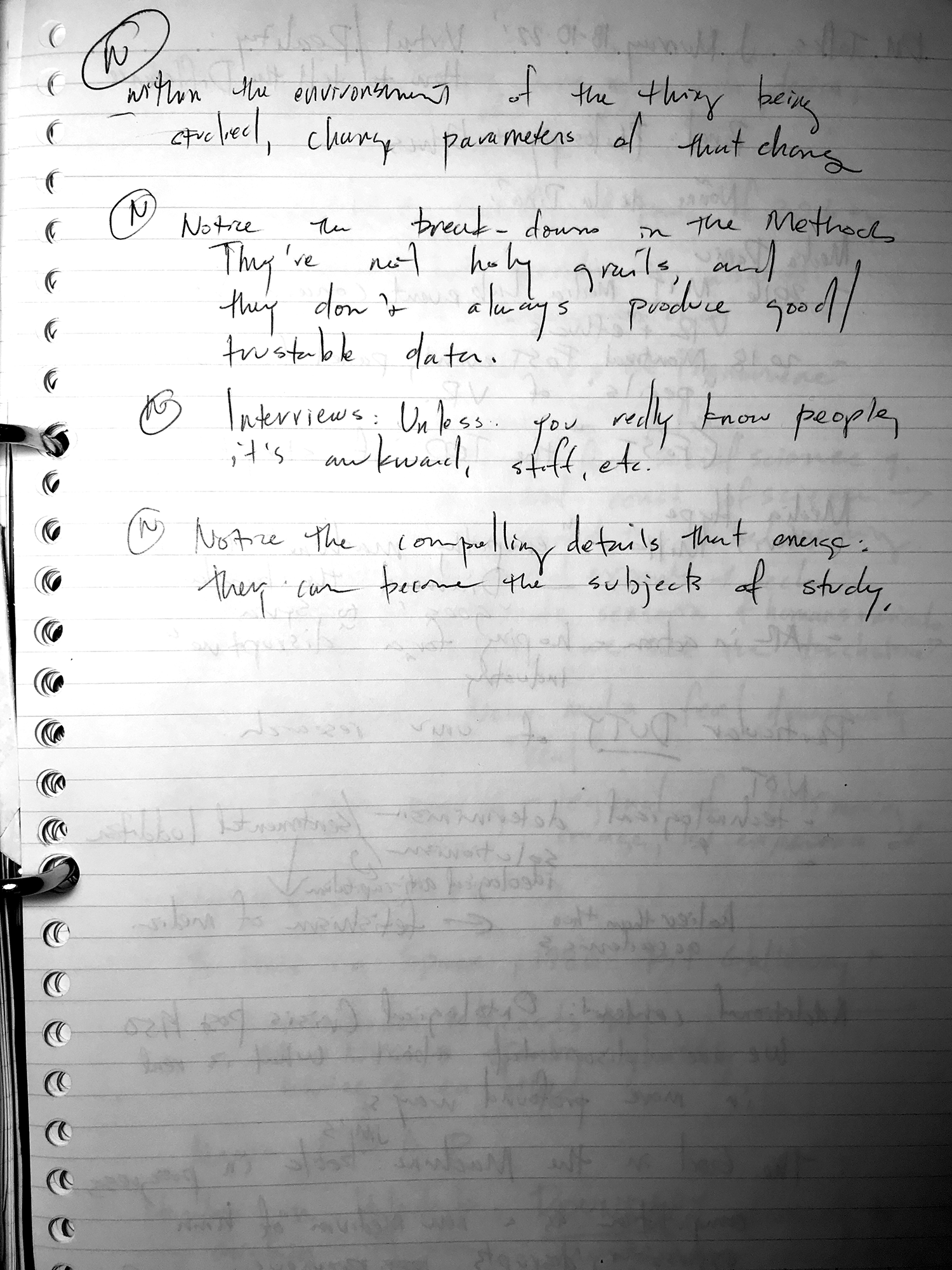
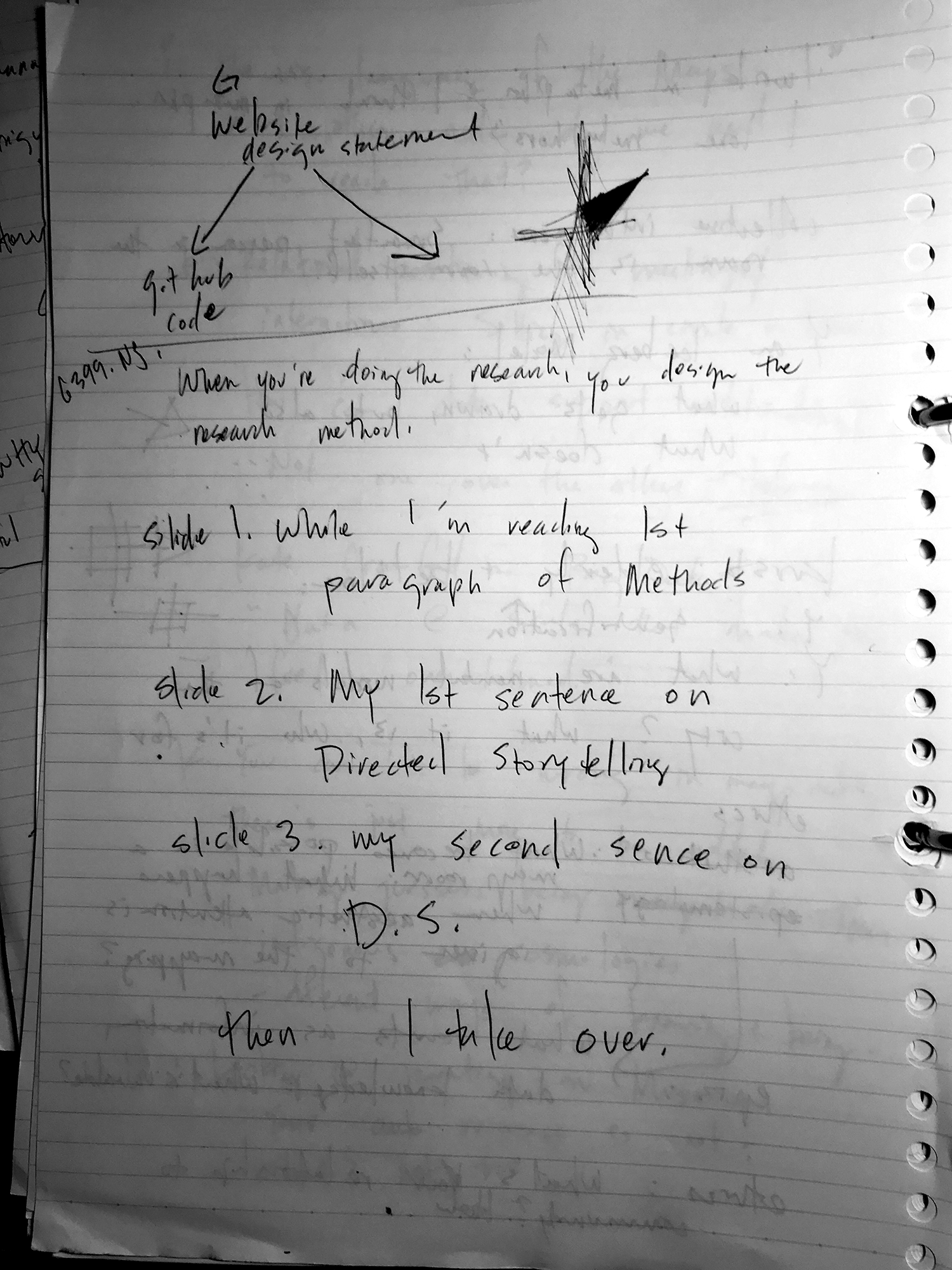


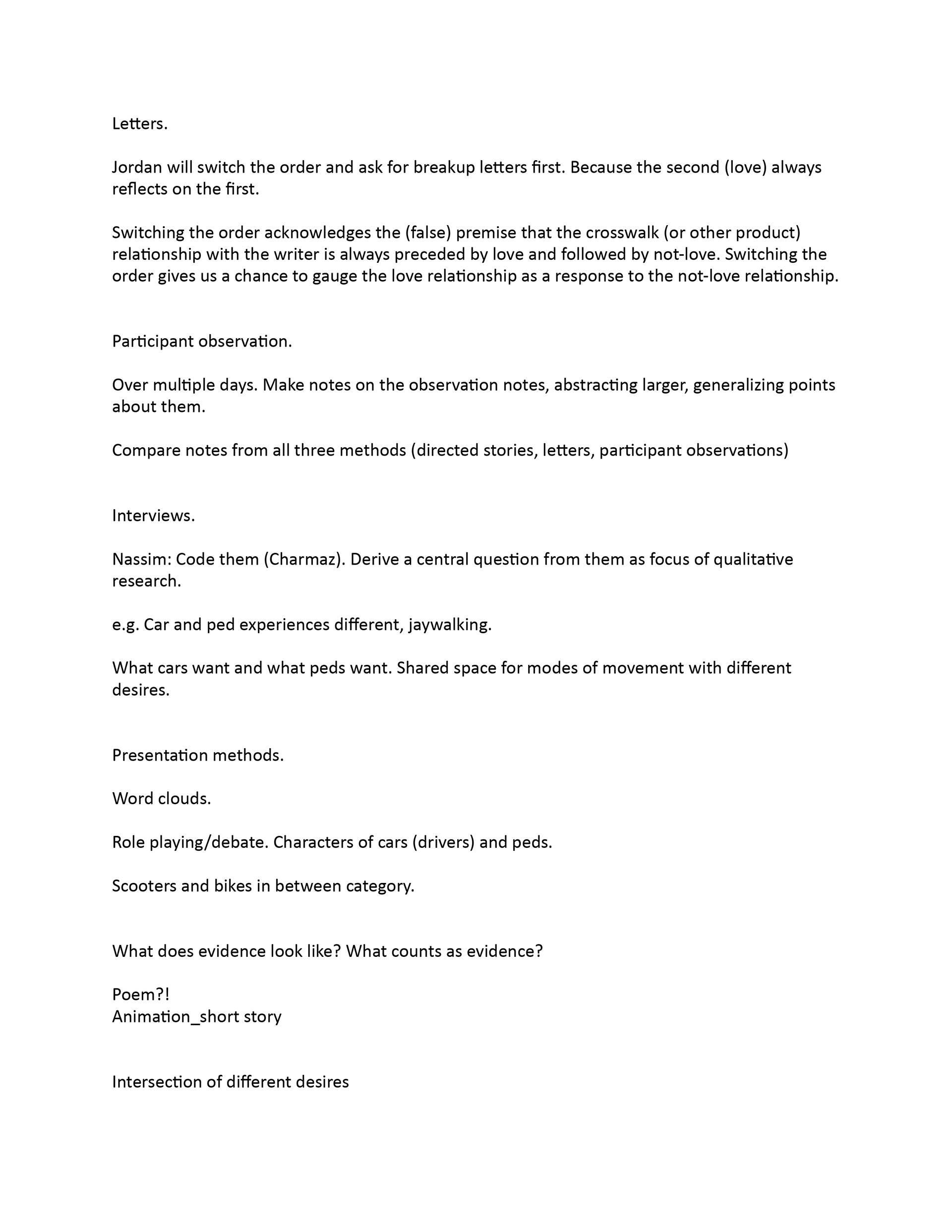

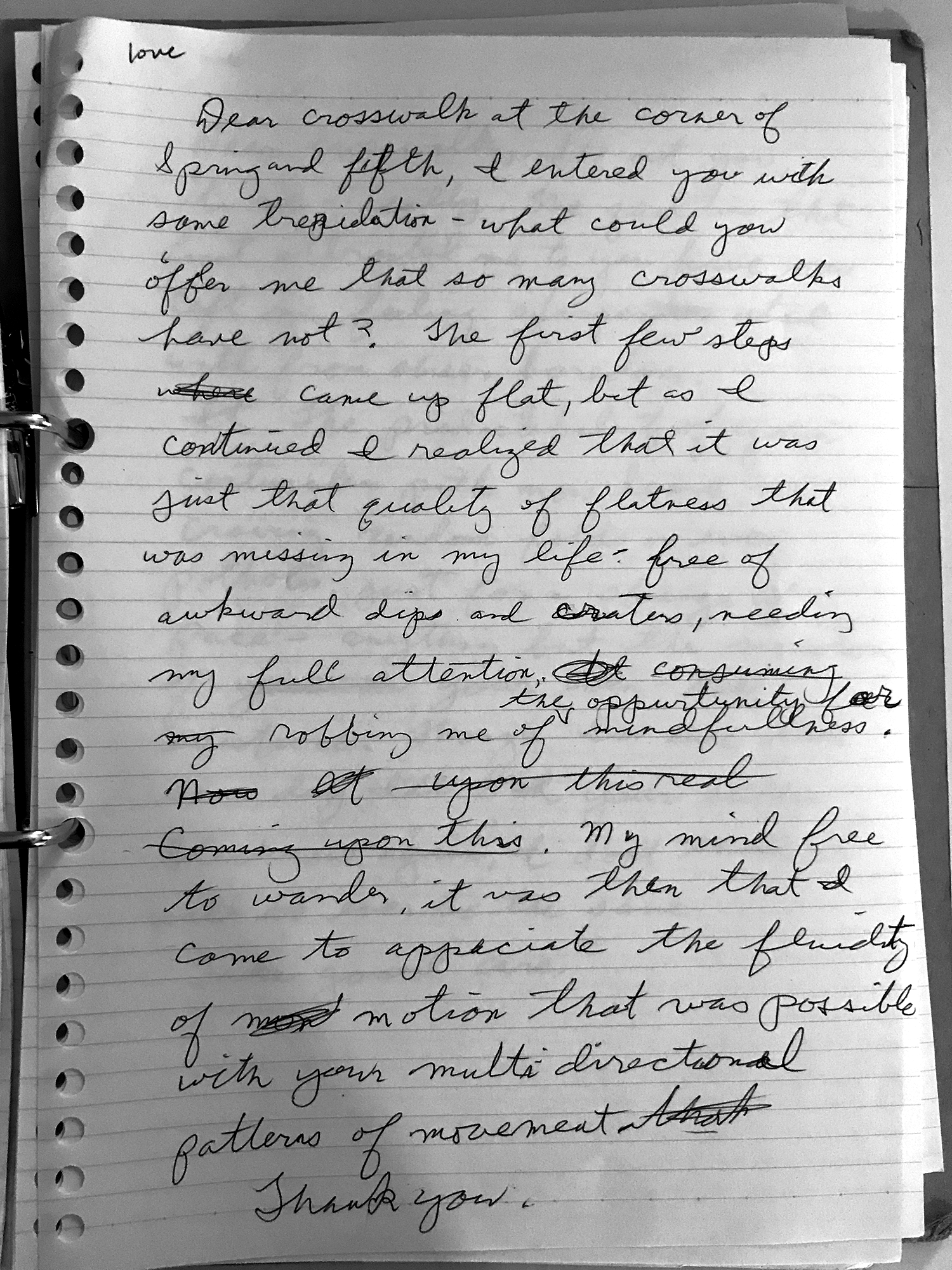
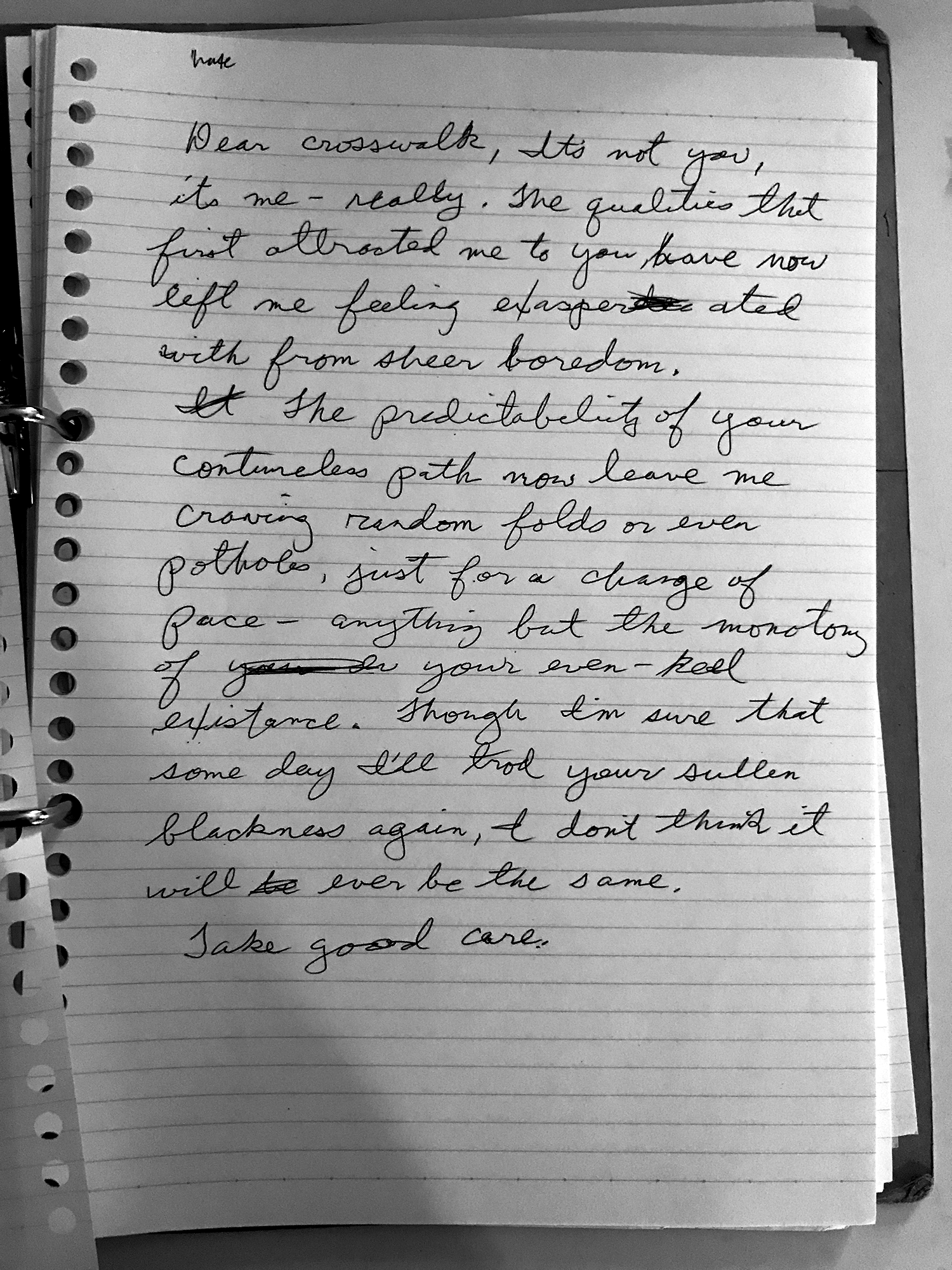

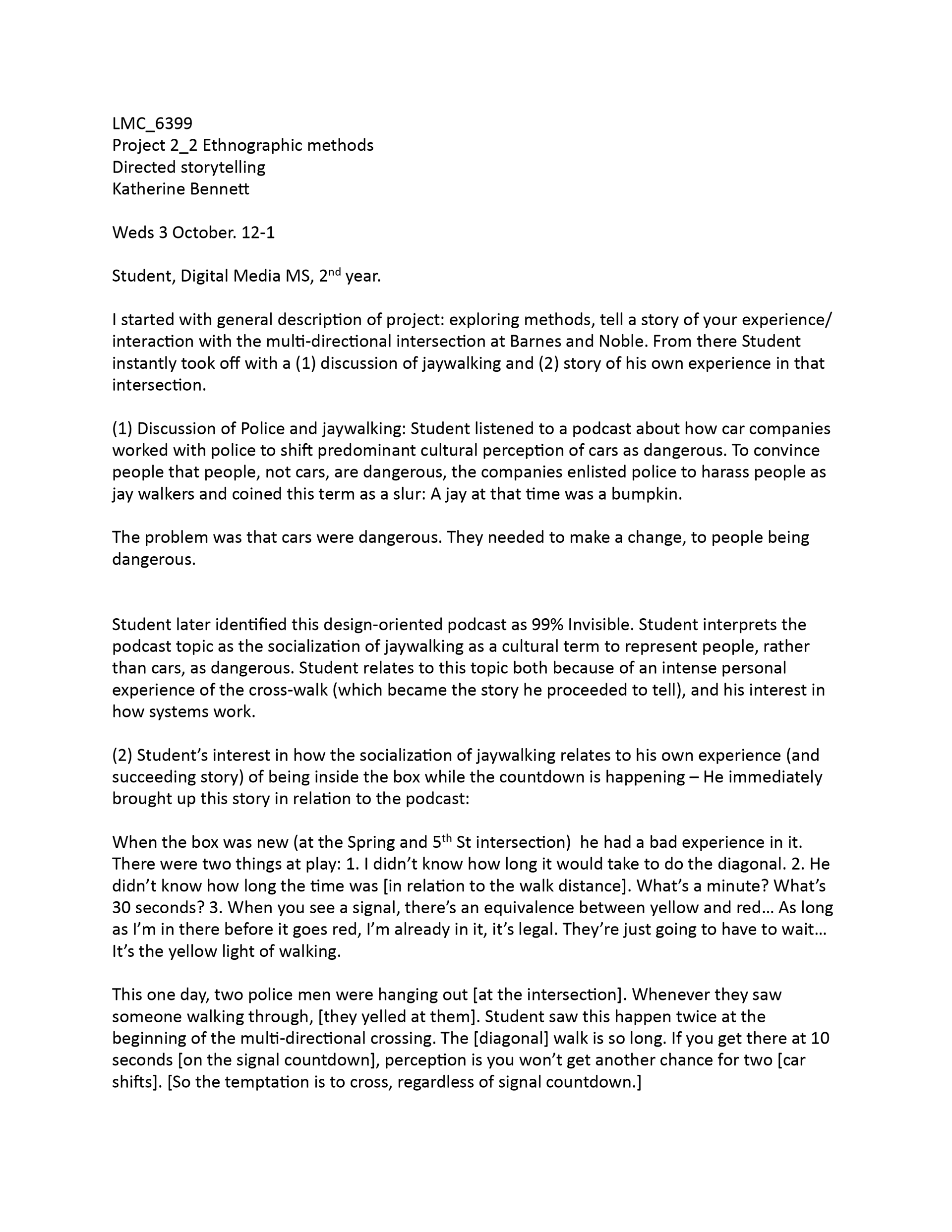





Individual and group process. (top far left and left, 2 images) Katherine Bennett, presentation notes. (top center) Group presentation notes. (top right) Katherine Bennett, notes for poem animation. (top far right) Group meeting notes. (middle far left) Katherine Bennett, love and breakup letters set 1. (middle left and center, 2 images) Katherine Bennett, love and breakup letters set 2. (middle right) Katherine Bennett, directed story 1. (middle far right) Katherine Bennett, directed story 2. (bottom far left) Samantha Hudock, letters and stories. (bottom left) Jordan Chen, participant observations. (bottom center) Jordan Chen, directed story 1. (bottom right) Jordan Chen, directed story 2. (bottom far right) Katherine Bennett, participant observations.


